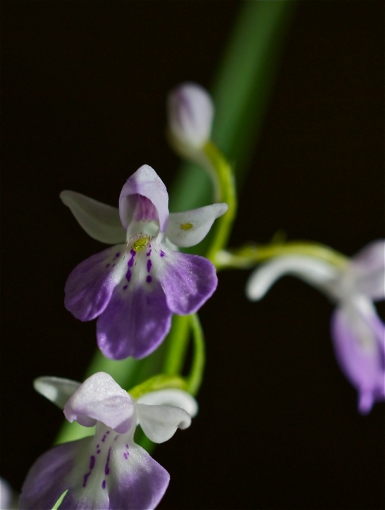PONERORCHIS GRAMINIFOLIA
This hardy to Zone 7/8 member if the Orchid family is native S. Korea and Japan (Honshu, Shikoku and Kyushu). It was authored and named in 1852 by the German botanist Henrich Gustav Reichenbach (1824-1889). It has been officially classed in the past as Orchis as well as Gymnadenia. But ever since Maekawa in 1971 with the publication of his beautifully illustrated Wild Orchids of Japan in Colour, the name Ponerorchis has held sway and continues to do so to this day.
The poneros part of its name is a Greek word meaning "useless". And while it may have been viewed as having no economic importance, on an aesthetic level there is no denying that this little terrestrial orchid is useful especially in a woodland planting where it can be treated much like the hardier Calanthe such as discolor, striata and tricarinata.
Thus, a woodland or rock garden situation with a gritty yet rich mix of leafmold and other organic components such as composted needles and humus seems to be de rigeur. They should have little direct sunlight (except benign morning sun to vaporize the dew, etc.) but rather filtered light. This context leads to good or better flowering.
My plant came from Jason Nearing and was purchased from him at the AGCBC Spring sale in West Van in 2010. I'm not sure if it was part of his recent plant/seed collection in Kyushu. I had it a shady woodland garden but it was too shady. I then moved it to a morning sun section of the woodland garden where it thrived before I dug it up and repotted it. It has done very well in the pot (5 1/2" Kord) and in this context has the added benefit of being able to better see and appreciate the flowers. It is worth noting that it was in flower for 3-4 weeks during the mid-summer and seemed to thrive in the heat.
Many people recommend an unheated alpine house. There is no reason that this should work really well if significant ventilation (large windows on either side of the house for cross-circulation) is provided.
In Japan there has been a lot of hybridizing work done with the subspecies suzukiana. This has resulted in a number of hybrids including the very showy cv, 'Yumechidori'.
Paul Cumbleton in his Wisley Log (sadly no more) Log 16, July 31, 2008 had a great long piece on UTYOURAN, the Japanese name forPonerorchis graminifolia. It can accessed here with this link:
http://www.srgc.org.uk/wisley/2008/010808/log.html
Cumbleton includes some good propagation pics as well as a good synthesis of a long article on the Japanese varieties by Gunther Kleinhans in the now defunct Pleione Review. For those wanting to delve deeper, Joyce Stewart's fine article in the New Plantsman (now called thePlantsman), 1994 Volume 1, Part 1 March 1994 is a must read. She unravels all the history of nomenclatural changes as well as providing some terrific cultivation instructions from the All Japan Orchid Society. Between these two long articles you shall be fully up-to-speed on things.
Ponerorchis graminifolia.Ponerorchis graminifolia synonyms after Karasawa 1987.Gymnadenia rupestrisGymnadenia graminifoliaOrchis rupestrisOrchis graminifolia
There also appears to be three infraspecific entities:
var. kurokamiana
var suzukiana (not to be confused with the P. x suzukiana of horticulture which is a cross with P. chidori) and,
var. micropunctata
There is an exceptionally beautiful painting by Christabel King on p. 31 of the New Plantsman article that clearly shows the differences with varmicropunctata being much taller than the other two varieties.
Here is another link that shows some good pics and more information from that online repository of solid horticultural and botanical information, The Culture Sheet.
http://culturesheet.org/orchidaceae:ponerorchis:graminifolia
Ponerorchis graminifolia (in all its forms and varieties) is a delightful and precious thing and one that fits nicely into the sensibilities of an alpine woodland gardener.
Here is one final link from the Dutchman, Rogier van Vugt. It is a photo gallery that he has assembled and it shows such a diversity of form and colour that it makes you cry with joy. See here: http://www.pbase.com/rogiervanvugt/ponerorchis_graminifolia
I have the feeling that this is not the last one that I will cultivate. I also believe that it is not all that difficult to keep it in cultivation but make sure that you don't mollycoddle it. Deep dormancy equals rest and rest equals rejuvenation and a willingness to flower/survive.
Here on the west coast, we have many of the natural vectors and rhythms that the DNA of this species requires and desires. With these meterological and photoperiod allies, we should be able to really grow them well. So far, so good.
Grahame WareNovember 2012Owl and Stump Rare Plants


